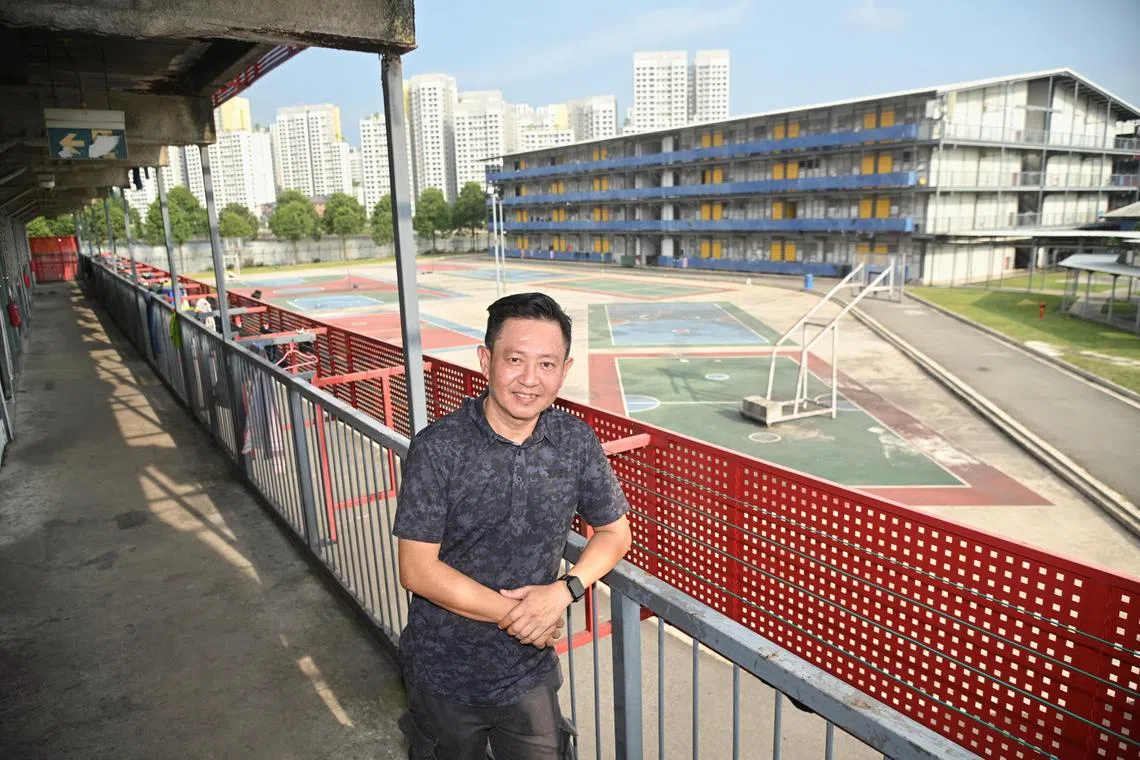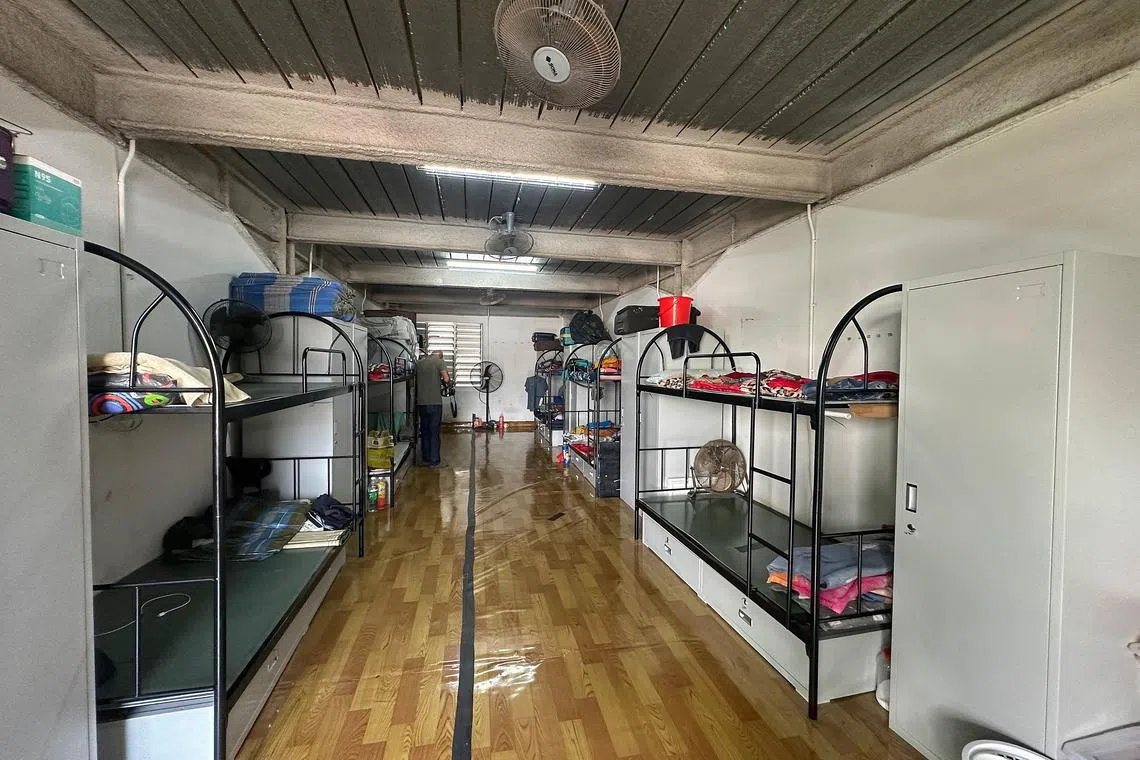Concerns over cost and reduced capacity, but operators see need to raise dormitory standards
Sign up now: Get ST's newsletters delivered to your inbox

Mr Kelvin Low, general manager of Tee Up Dormitory, says dorms should go beyond simply complying with the new infrastructural requirements.
ST PHOTO: DESMOND WEE
Kok Yufeng
Follow topic:
SINGAPORE – It will cost Ms Jolene Teo about $80,000 to renovate the dormitory in her company’s Tagore Lane factory, which currently houses 28 of her workers in a single large room.
The director of Southern Airconditioning Engineering said about half of that amount will go towards building four en-suite toilets as part of her plans to add more rooms and beds to the premises.
Needing the extra accommodation to bring in new workers, Ms Teo started planning the retrofitting works even before the Ministry of Manpower (MOM) announced a transition scheme on Wednesday for about 1,000 foreign worker dorms to improve their housing standards.
Over a four-year period from 2027 to 2030, the vast majority of these existing dorms will need to meet an interim set of requirements, which include a cap of 12 people per room and mandatory en suite toilets. By 2040, the 1,000 dorms will have to comply with even higher standards that were announced in 2021.
Dormitory operators have baulked at the costs they will need to fork out to make these upgrades, but those The Straits Times spoke to also recognised the need for standards to be raised.
Ms Teo said she has no choice but to pay what is necessary to renovate, as it would cost her even more to house her workers in commercial dorms, where rental rates for a single bed have shot up to $550 a month.
Another worry among operators is the impact that retrofitting dorms will have on their bed capacity.
Mr Goh Boo Kui, contracts director of Unison Construction, said his company’s dormitory in Tuas will likely need a major redesign if it were to meet all of MOM’s interim requirements.
Due to the way the factory is configured, limiting each room to 12 residents means sacrificing beds in the larger corner rooms, where 20 people currently sleep.
He said the company is unlikely to be able to build en-suite toilets for every room, and he intends to ask MOM for a waiver. But even if he is allowed to continue with communal toilets, Mr Goh said they will need to be enlarged, which will take away space that could be used for beds.
At a media briefing on Wednesday, MOM said it is mindful of the tight dorm bed supply and soaring bed prices, which is why the transition period for dorms to meet the interim standards is set between 2027 and 2030.
“If we do it now, that is going to aggravate the problem,” MOM added.
Mr Eugene Aw, second vice-president of the Dormitory Association Singapore Limited, said he is glad that the Government took the interests of dormitory operators in account. He said MOM’s transition plan is “reasonably phased out”, and while there are concerns among operators about costs and the impact on occupancy, the view is that these issues can be contained.
Mr Aw said dorm operators initially questioned why the changes were needed. “But as the messaging is pushed out, the more forward-thinking ones will start accepting that this is a fact of life, and eventually, the entire industry will start moving forward together with these new standards,” he added.
Mr Kong Chee Min, chief executive of Centurion Corporation, one of the largest dorm operators in Singapore, agreed that the timeframe for MOM’s transition scheme is well thought out.
“There will be a new supply of beds over the next three to five years, so when we do the transition from 2027, there will be sites for workers to move into,” he said.

A Tee Up Dormitory space shows six bunk beds for 12 foreign workers who will share an en suite toilet facility.
ST PHOTO: DESMOND WEE
MOM has said that over the next five years, at least seven new purpose-built dormitories with a total of 47,000 beds are expected to be completed. Two of them will be built by MOM, while the remaining five will be tendered out to commercial operators.
Centurion said its five purpose-built dormitories (PBDs) already meet some of the interim housing standards, such as en suite toilets. But retrofitting will be needed to meet other specifications, such as the more stringent requirements for isolation facilities and the minimum living space of 3.6 sq m per resident.
The company estimates that in 2030, its current PBD capacity of more than 27,000 beds will shrink by 3 per cent to 11 per cent due to these renovation works.
To mitigate this, plans are afoot to partially redevelop two of the company’s PBDs – Westlite Toh Guan, which sits on land that has a remaining lease of 34 years, and Westlite Mandai, which sits on freehold land. Works are expected to start in early 2024, pending written approval.
At Toh Guan, one dormitory block has been taken down, and a larger one will be built in its place. In Mandai, a third dorm block will be to built, in addition to the existing two.
Centurion said the move will bolster its current bed capacity before it needs to start progressively retrofitting all of its PBDs from 2027. This will minimise the reduction in beds that it will be able to supply during the transition period.
Asked what a reasonable amount of financial support from the Government should be, Mr Kong said he hoped that up to 80 per cent of the cost could be covered, but discussions on this are still ongoing.
He added: “This is a retrospective application of a new standard. It has never happened before... So, it is only fair that the Government supports dormitory operators.”
For Straits Construction chief operating officer Kenneth Loo, Covid-19 has shown that the industry needs to work towards raising the standards of dorms here. “We cannot keep status quo. We need to improve,” said Mr Loo, whose company runs its own 750-bed dormitory in Kaki Bukit.
Mr Kelvin Low, general manager of Tee Up Dormitory, which runs PPT Lodge 1A in Seletar North, said dorms should go beyond simply complying with the new infrastructural requirements and take into account how migrant workers view their living spaces.
Mr Michael Lim, executive director of the Migrant Workers’ Centre (MWC), said he has already seen positive changes in dormitory conditions here.
He hopes more can be done to improve housing standards across the board, including for dorms that are exempted from MOM’s transition scheme.
“While infrastructure changes are crucial, MWC recognises that there are other challenges in migrant worker dormitories that continue to require attention,” he added, citing distribution and storage of meals for workers as an example.
The Humanitarian Organisation for Migration Economics said it is crucial that the additional costs of retrofitting dorms are not passed down to workers.
“Despite the announcement that there will be some financial support rendered to dormitory operators, employers may still be incentivised to deduct additional costs from migrant workers’ salaries.”
For Mr Ripon, a Bangladeshi worker in the oil and gas sector, his biggest gripe after living in a PBD in Tuas for the last seven to eight years is the number of people crammed into each room.
The 46-year-old, who goes by one name, lives with 15 others, and while there is an attached toilet, the wait to use the washroom can also be long, especially before and after work.
“Twelve people in one room is okay, it is better,” Mr Ripon said when told about MOM’s new standards.
However, while he said 2027 is a reasonable time to wait for these changes, 2030 is too far in the future for him.

